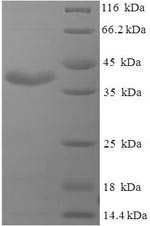The synthesis of Recombinant Pig PRL protein began with the isolation of PRL gene from the native genome. The next step was to amplify the PRL gene by inserting the PRL gene into an expression vector and then introducing the vector into the selected host cell, E.coli. Significant amounts of recombinant Pig PRL protein were produced by the host only when expression genes were added. For the purpose of protein purification, the vector contains N-terminal 6xHis-SUMO tag to the PRL DNA sequence. The purity of this protein is 90%+ determined by SDS-PAGE.
PRL is a gene encoding a protein named prolactin (PRL)(also known as lactotropin) in enabling mammals. The protein encoded by this gene can bind to prolactin receptor and has hormone activity s produced by the pituitary gland, a small gland at the base of the brain. It promotes lactation (breast milk production) in mammals and plays an essential role in metabolism, regulation of the immune system and pancreatic development.






